
This particular summer continues to be incredibly busy here, but I’m enjoying switching heads between creative and technical tasks as things move forward. Thunderbean will never be Warner Bros (or even the Ritz Brothers for that matter!) but I’m very happy technology is at the point it is at a time where there is the ability to work with such amazing materials.
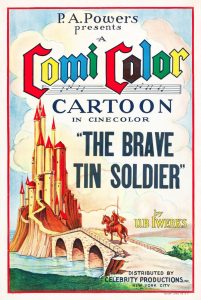 This week has seen a bunch of work on Grotesqueries, bringing it amazingly close to the finish line. It’s down to the co-producer’s approval of the FBI title sequence! The first two versions didn’t pass, so keep your fingers crossed that version 3, or 4, or 5 will!
This week has seen a bunch of work on Grotesqueries, bringing it amazingly close to the finish line. It’s down to the co-producer’s approval of the FBI title sequence! The first two versions didn’t pass, so keep your fingers crossed that version 3, or 4, or 5 will!
I spent a little of the week scrubbing children’s drawings off of an otherwise lost Oswald cartoon (more on that later), carefully repairing splices on material from a famous background designer’s estate (more on that later too), finding clips for a cartoon related project, trying to finalize another major project, and working on the usual ones. We’re scanning stuff out of town on Friday, and that’s what I’m looking forward to most!
I look at the three series we’re releasing with Blackhawk as a unique opportunity. Preservation of the films isn’t a question at this point on these films; there’s enough copies of them in existence that we won’t lose them per se. I see Thunderbean’s role at this point in time to help preserve as well as release the best version possible of each film. I’m continually reminded of how many possible ways there are to get through a project like this in terms of what material to use. Doing the absolute best version of each is, for the most part, not the easy road, and I discovered on the Willie Whopper project and Flip.
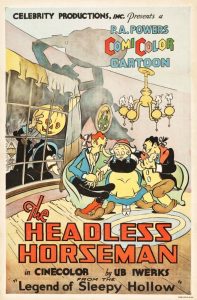 Materials in color present even more challenges in going further back where negs and master positives exist. Since the scanning of Hell’s Fire and Davy Jones’ Locker I’m of the opinion that the first best option is to at least *try* to use the earliest generation of material, even though it’s more work. Often the reason that it hasn’t been used again is all the past extra issues in recombining them since it was easier to just scan a print. All of them seem to have a decent nitrate print in existence in the master materials, and some *only* now have prints. Others have their original camera negs or master positives, and some only have one of the two colors in masters.
Materials in color present even more challenges in going further back where negs and master positives exist. Since the scanning of Hell’s Fire and Davy Jones’ Locker I’m of the opinion that the first best option is to at least *try* to use the earliest generation of material, even though it’s more work. Often the reason that it hasn’t been used again is all the past extra issues in recombining them since it was easier to just scan a print. All of them seem to have a decent nitrate print in existence in the master materials, and some *only* now have prints. Others have their original camera negs or master positives, and some only have one of the two colors in masters.
David Shepard was very kind in granting the license to the Blackhawk materials; as I continue with these last of these projects with Blackhawk (the Comi-Color shorts), David himself was quick to point out that since the 70s there has been a continual effort to preserve pieces of this series as well as the others that Iwerks made before it was too late. This has involved inspection and preservation often as an element is just starting to go. The reasons are unclear currently as to why some elements go faster than others, but here are a few guesses.
In this stage of the project, I’ve noticed that most of the original nitrate soundtracks for the Comi-Colors do not exist any more. Interestingly, these materials were often preserved by UCLA and David Shepard before they were pitched. It wasn’t until I started inspecting the tracks that existed that it became pretty clear why they may be the first to go. The tracks have generally been printed on news film stock, pointed out by several archivists while I was looking at materials. The news film stock was generally cheaper than other stocks— so my guess is that Pat Powers went as cheap as possible making the sound masters— or it was just common practice at Cinecolor to do so. Since there are prints of all the films in 35mm, there is still decent soundtracks, but sometimes the blue tracks of Cinecolor prints are not quite as clear.
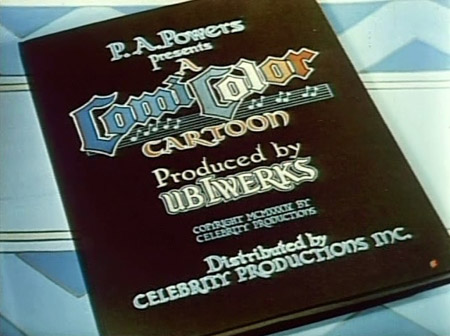
There are 25 films in the series. Here’s a little report of the state of the masters on the earliest films. We’ve starting with these first.
The earliest films in the series are the ones with the least amount of choices in terms of master materials. The first film, Jack and the Beanstalk only has only two nitrate prints. These have been preserved with safety materials made in the late 90s. We’ll scan the original nitrate on both to get the best alignment in shots since the material is limited.
The second in the series, The Little Red Hen is even a little more problematic. There are no original masters beyond two nitrate prints, both with some wear. One was used as a master to make a color Eastman neg for Commonwealth’s release of the film to television. The original title and end title are lobbed off and replaced with their ‘Fairy Tales’ title. The other print was probably used to make Blackhawk’s 16mm reduction negative. We’ll scan both of these as well.
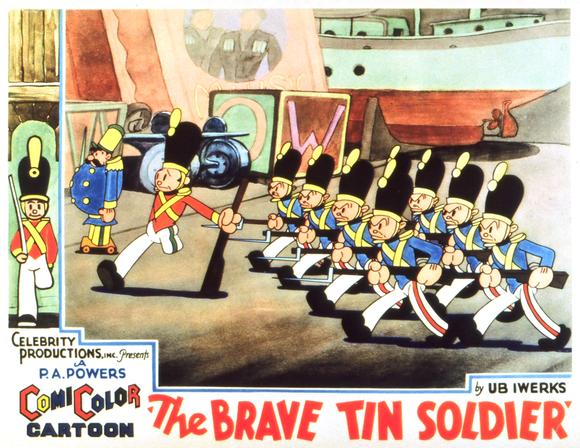
The third, Brave Tin Soldier, has a little more variety to choose from. There are four nitrate prints, but no other master materials. All four prints look pretty similar to me, so making the call on what to scan is difficult with seeing all of them (and that would require scanning all!). A hard call to make on this one at the moment, so we’ll likely start with one and see how its looking.

Number four in the series is Puss in Boots, and happily the original camera material exists. This consist of two negatives on black and white film stock. These negs were shot together using an in-camera prism system, or the stock was bipacked with one neg being sensitive to only one spectrum of color. The material is in absolutely beautiful shape overall, but we’ll see that better when its scanned. There are also two prints of the film, so we’ll scan the soundtrack from one of those.
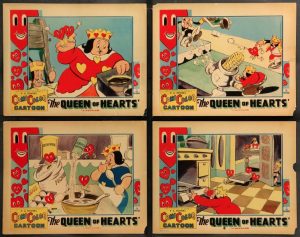 The fifth is The Queen of Hearts, and similar to Puss in Boots it has its original negs and four prints. One of the cool things about these original negs is that it’s pretty clear that no one has gone back to them since the films were made— relying on prints of the films instead. At least one of the films (Balloon Land) did have its original negs used in more recent years, so we have an example of how good they can look.
The fifth is The Queen of Hearts, and similar to Puss in Boots it has its original negs and four prints. One of the cool things about these original negs is that it’s pretty clear that no one has gone back to them since the films were made— relying on prints of the films instead. At least one of the films (Balloon Land) did have its original negs used in more recent years, so we have an example of how good they can look.
Number six, Aladdin and the Wonderful Lamp, sadly, is missing master material. There are only two nitrate prints, but both are quite nice.
Number seven is The Headless Horseman. There is only the red neg in existence, and the soundtrack, and five Cinecolor prints. This is another one I’m debating on, but will most likely scan a print to see what its looking like. The production code is extant on at least a few of the prints.
Number eight, The Valiant Tailor, has its two negs and a single print. Some of the negs are wound really tight on one end (almost pencil thin), and its hard to say how well that will scan in these cases. I’m crossing my fingers!
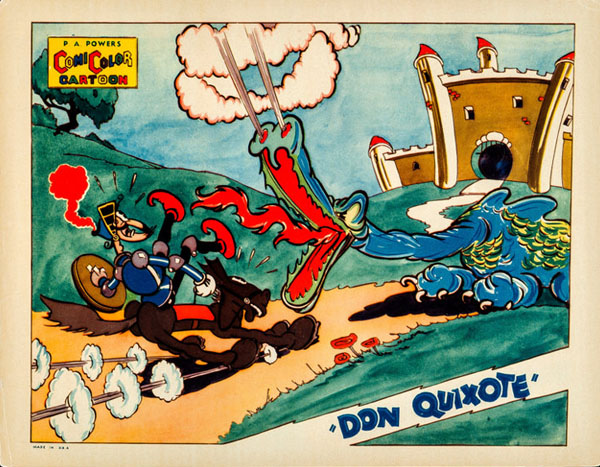
Number nine, Don Quixote, survives in a single nitrate print as a master. I’ll be careful (as always!).
The tenth, Jack Frost, is one of my favorites of the series. It has preservation materials done on it, happily, and the original nitrate track preserved as well. Both red and blue negs exist, *and* the master positives duped off them, so if the negs don’t look amazing we have a master backup. From my condition report I noted they looked stunning.
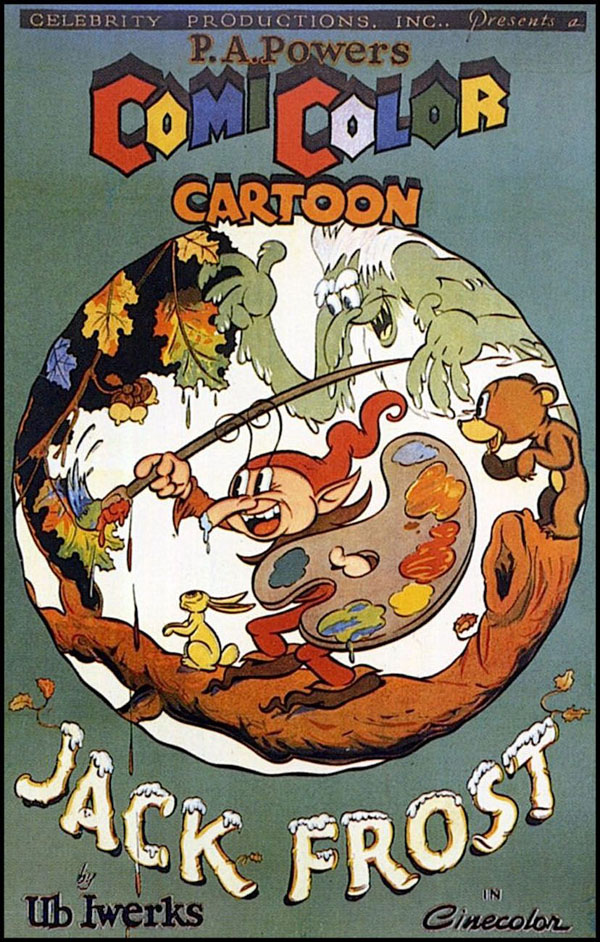
Number 11 is Little Black Sambo. While the other titles in the series have long been available with their original titles, Sambo has not been. Blackhawk never reissued the short, and that left the only prints around being the ones made by Castle Films in the 40s into the early 60s. The blue and red master positive both exist and are in good condition. There are also *nine* nitrate prints in the master materials on this title!
Starting to scan these is an exciting venture for us, and we’re very much looking forward to giving some sneak peaks as these finally see the light of day again!
Have a great week everyone!


 Steve Stanchfield is an animator, educator and film archivist. He runs Thunderbean Animation, an animation studio in Ann Arbor, Michigan and has compiled over a dozen archival animation DVD collections devoted to such subjects at Private Snafu, The Little King and the infamous Cubby Bear. Steve is also a professor at the College for Creative Studies in Detroit.
Steve Stanchfield is an animator, educator and film archivist. He runs Thunderbean Animation, an animation studio in Ann Arbor, Michigan and has compiled over a dozen archival animation DVD collections devoted to such subjects at Private Snafu, The Little King and the infamous Cubby Bear. Steve is also a professor at the College for Creative Studies in Detroit.






















Aw man the original titles on that last one is lost? Where are you going to find it? a title recreation CANNOT do it justice since the home movie titles were made for Castle.
No! The titles are intact on the materials I’ve looked through– they just haven’t been seen since original release!
Interesting post, as always. I still don’t quite get how the soundtracks are finally married to the visuals when it comes to both the original creation of the cartoon and its transfer to digital, but Mark Kausler once tried to explain it to me, and he stated as well that the “blue” soundtracks would sound a little “dull” by today’s standards. Thus, when you listen to a cartoon like the HAPPY HARMONIES title, “THE OLD PIONEER”, it sounds somewhat muffled, and this is probably the only existing source material to this short now since original elements were lost in an MGM fire.
I wonder how far digital technology can go to improve on that soundtrack, if at all, without it sounding somehow unnatural…in other words, not any longer sounding as if it actually came from the 1930’s. Like I’ve said before, I like the actual sound of the age of older movies. If it came from the 1930’s, I like it to sound that way, but there are problems with original sources in that the film itself can sound too aged beyond the natural analogue tone of the film as it sounded upon official release. The digital noise reduction equipment alone cannot be counted on to transfer the sound from film and leave it still sounding like film. It detects stuff as “noise”, not surface noise that belongs there because you’re transferring from film. Succeeding in making that transfer must really make you feel good. One has to know exactly what the film sounded like originally, and having said that, I wonder what “THE OLD PIONEER” would sound like if it were possible to lightly improve the sound and leave it sounding analogue. Am I making any sense here?
Needless to say – but I’ll say it anyway – I wish you all the best in getting some of these things fully restored. I have to admire your dedication. I wish your staff could work with the bigger companies, getting them to realize that the older the masters, the more they need to be dealt with before fires occur. No doubt you’ve heard of the 2008 Universal fire that apparently destroyed a lot of music of all decades. Of course, the ones who lost the most were the golden voices of Bing Crosby and the kinds of recordings from that era that are still beloved simply because we kids knew them from caricatures in cartoons. Let’s hope that your efforts do not meet with the intensified heat of summer to kill the joy of seeing full and complete restorations.
I know these posters all say “Distributed by Celebrity Productions,” but what does that actually mean? That Celebrity Productions distributed these independently? That these cartoons had no major studio affiliation? That they weren’t even handled by an independent distributor like United Artists? That can’t have been a very efficient or effective way to get these films into theaters, with a tiny outfit like Celebrity trying to compete with the cartoons the major studios were offering and coould circulate more effectively through their coast-to-coast exchanges.
The Comi-Color cartoons were released by Pat Powers’ Celebrity Productions via the state’s rights system, which means that rather than being handled by a single national distributor, they were sold to various regional distributors. The state’s rights system dated to the early years of the motion picture industry, but by the 1930s it was utilized mostly by low-end producers. In the case of the Comi-Color cartoons, Iwerks and Powers likely had no other way to get the cartoons out there, given that MGM had lost interest in Iwerks’ films and that there were no other studios out there who needed them. They either had their own cartoon studios or were already affiliated with an independent producer. The poverty row studios were in no position to handle a series of expensive color cartoons. I’ve wondered if Iwerks and Powers were hoping that the Comi-Colors would be well-enough received to attract a national distributor. The problem with the state’s rights system, from a financial point of view, is that the producer had to split the box office take with all those regional distributors, which made it very difficult to make a profit.
I’ve always had a soft spot in my heart for the Comic-Color cartoons. They’re so weird and unpredictable in a lot of cases. Then again, I suppose you could say that about a lot of the output from the Ub Iwerks studio. I can’t wait to see these cleaned up (and to see Flip once it’s completed)!